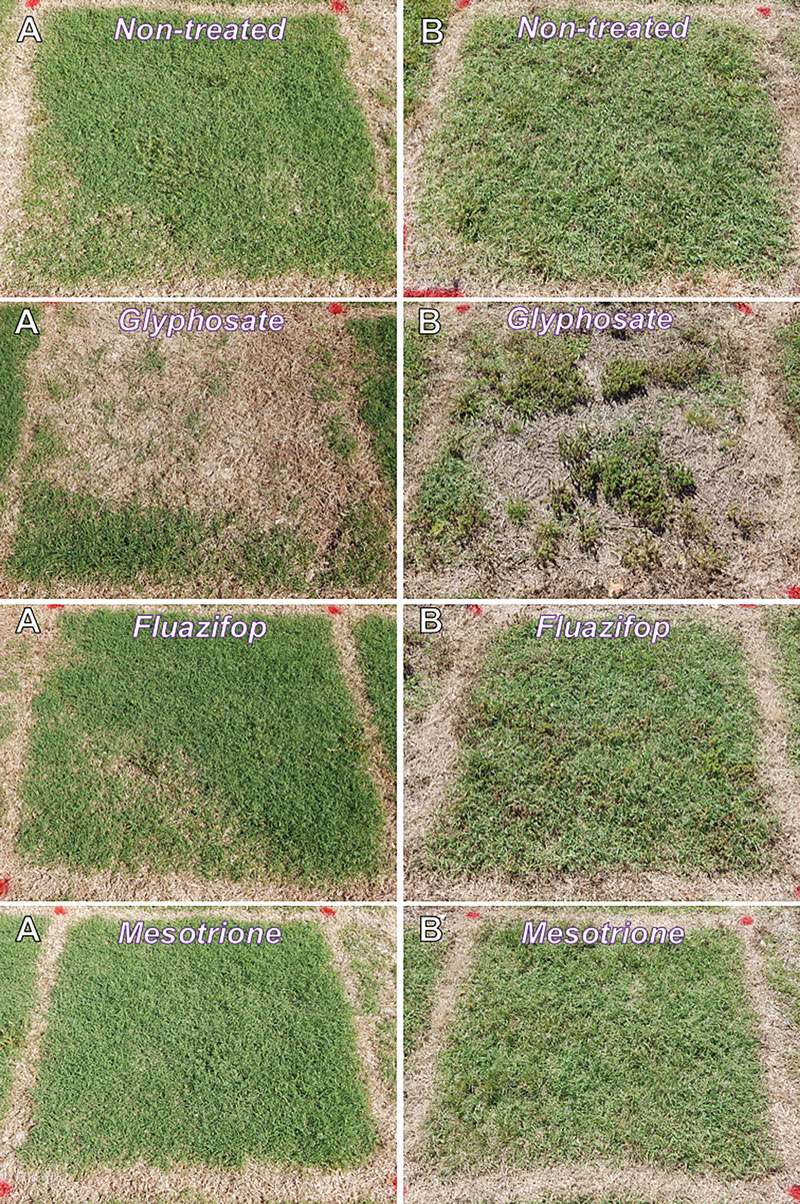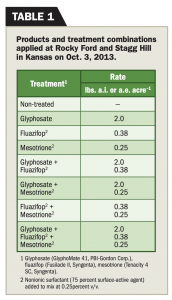Efficacy of late-season bermudagrass removal using herbicide combinations

Figure 1. (A) ‘Midlawn’ bermudagrass plots and (B) common bermudagrass plots on June 12, 2014 (252 days after application on Oct. 3, 2013) recovering from autumn applications of glyphosate, fluazifop and mesotrione combinations. All other treatments containing glyphosate (not pictured) had a similar percentage of green cover as glyphosate plots and plots treated with fluazifop and mesotrione (not pictured) had a similar percentage of green bermudagrass cover as those treated only with fluazifop. (Photos: Jared Hoyle, Ph.D.)
Multiple summer applications of glyphosate at rates up to 3.75 pounds acid equivalent (a.e.) acre-1 are commonly recommended for bermudagrass (Cynodon spp.) control (1,3,5). However, this regime results in an extended period of 3 to 4 months of displeasing and nonfunctional turfgrass and is not ideal for spring establishment.
An autumn glyphosate application before winter dormancy in the Southern U.S. can control bermudagrass and benefit spring establishment projects (2,3). However, researchers have not evaluated this strategy in the Central Plains region.
We wanted to define the parameters for late-season herbicide applications to control bermudagrass as it transitions into dormancy in the Central Plains. Recommendations and previous research support adding herbicides such as fluazifop or mesotrione to improve nonselective control of bermudagrass (5)
This experiment aimed to examine the efficacy of late-season bermudagrass removal using glyphosate, fluazifop and mesotrione herbicide combinations.
Materials and methods
We initiated experiments on Oct. 3, 2013, at the Rocky Ford Turfgrass Research Center in Manhattan, Kan., on mature ‘Midlawn’ hybrid bermudagrass and at Stagg Hill Golf Course in Manhattan, Kan., on mature common bermudagrass. At both sites, we maintained research plots (5-by-5-foot) at a 3-inch mowing height.
Seven herbicide treatments containing glyphosate (GlyphoMate 41, PBI-Gordon Corp.), fluazifop (Fusilade II, Syngenta) and mesotrione (Tenacity 4 SC, Syngenta) were arranged in a randomized, complete block design with four replications at each site. The team applied herbicide treatments with a CO2–pressurized boom sprayer equipped with XR TeeJet 8004-VS flat-fan nozzles calibrated to deliver in 44 gallon acre-1 at 40 psi.
 We based product application rates (Table 1) on extension recommendations and previous research (2,3,5), and we included an untreated control.
We based product application rates (Table 1) on extension recommendations and previous research (2,3,5), and we included an untreated control.
We visually estimated green bermudagrass cover (ranging from 0 to 100 percent) when we initiated treatments and every 14 days after application (DAA) until the bermudagrass was completely void of green cover (Oct. 31, 2013). Data collection resumed before spring green-up on May 2, 2014, and continued until Aug. 25, 2014 (326 DAA).
We conducted a separate analysis for each site to limit confounding effects from cultivar differences. Data were subjected to ANOVA using the GLIMMIX procedure of SAS (SAS 9.3, SAS Institute) with block as a random effect. Means were separated using Fisher’s protected LSD test (P < 0.05).
Results and conclusions
All treatments reduced green bermudagrass cover at each site at 14 DAA (Figures 1 and 2), excluding mesotrione at Rocky Ford, mesotrione, fluazifop and a combination of mesotrione, fluazifop at Stagg Hill. However, only treatments containing glyphosate delayed spring green-up at each location the following year.

Figure 2 — Percentage green cover of ‘Midlawn’ bermudagrass 14 to 326 days after application (Oct. 17, 2013, to Aug. 25, 2014) at Rocky Ford Turfgrass Research Center. Different letters on observation dates indicate significant differences at P < 0.05).
Treatments at Rocky Ford resulted in a similar ‘Midlawn’ green cover compared to the non-treated control by July 25, 2014 (Figure 1). At Stagg Hill, common bermudagrass treated with glyphosate or mixes containing glyphosate had significantly less green cover (≤ 38 percent) at the last rating on Aug. 25, 2014 (Figure 2)
Across all rating dates and locations, adding mesotrione, fluazifop or both to glyphosate did not further reduce green bermudagrass cover, which is different from previous research (5).
Differences in green bermudagrass cover between cultivars may have been due to improved genetics of ‘Midlawn,’ which is known to have improved stand persistence and cold tolerance compared to common bermudagrass (4). The reduced cold tolerance of common bermudagrass may have enhanced the efficacy of glyphosate treatments at Stagg Hill.
Similar to our results with ‘Midlawn’ bermudagrass at Rocky Ford, other research (2) reported that a single autumn application of glyphosate reduced Tifway hybrid bermudagrass cover but did not give complete control.

Figure 3 — Percentage green cover of ‘Midlawn’ bermudagrass 14 to 326 days after application (Oct. 17, 2013, to Aug. 25, 2014) at Stagg Hill Golf Course. Different letters on observation dates indicate significant differences at P < 0.05).
Overall, results indicate that a single autumn application of glyphosate before bermudagrass dormancy reduces turfgrass cover the following spring. Treatments containing glyphosate resulted in a similar or slightly faster appearance toward winter dormancy when compared with untreated bermudagrass and delayed spring green-up.
Adding mesotrione, fluazifop or both to autumn glyphosate applications did not enhance bermudagrass control in our experiments. Even though we observed a significant reduction at spring green-up, turf managers may need to make additional applications in the spring for increased efficacy before spring establishment.
Further research is needed to optimize autumn glyphosate application rates and the combination of autumn and spring applications for more efficient bermudagrass control.












